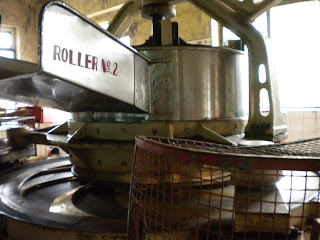This is Part 4 of my series on the Wonder Beverage. (Part 1, Part 2 and Part 3)
The conversion of fresh tea leaf to the black tea of commerce involves a series of transformations. The factory where tea processing takes place can be compared to a laboratory where fascinating chemical and biochemical reactions take place.
The manufacturing process of black tea consists of the following 5 stages after the leaves are plucked: Harvesting, Withering, Rolling, Fermenting, Firing, and Grading.
(Picture from Encyclopedia Britannica Mobile)
Harvesting: The slopes with closely cropped tea bushes are dotted with women in bright colourful clothing, carrying cane baskets on their backs, carefully picking the leaves. Experience is needed to handle this delicate job of plucking the tea leaves. The most tender first two leaves and the unopened bud are selected by experienced hands. The chemical composition of this plucking unit of 2 leaves and the bud is such that it gives the optimum quality to the processed beverage. If the process is mechanized, quality may be compromised for quantity.
(Picture obtained from Tea Pluckers in Nuwara Eliya)
Withering: The leaves are spread and warmed on wire or nylon racks. When they become limp and acquire a ‘kid—glove’ feel, they are ready for the next stage.
(Picture taken at the Tea Research Institute, Talawakelle, Sri Lanka in June 2011)
Rolling: can be done by hand or by machines. This process breaks up the cells and releases the natural juices of the leaf where enzymes act upon polyphenolic compounds present in the leaf. Rolling damages the tea leaves and initiates a chemical reaction between tea leaf polyphenols more specifically the catechins in tea, and an enzyme in the leaves known as tea polyphenol oxidase.
(Picture taken at the Tea Research Institute, Talawakelle, Sri Lanka in June 2011)
Fermentation: During fermentation this reaction is allowed to proceed. At the end of this process the leaves tum a copper colour. This is the crucial stage, because under fermenting makes the tea bitter, (green), over fermenting too results in inferior flavour.
(Picture taken at the Tea Research Institute, Talawakelle, Sri Lanka in June 2011)
Firing: Drying the leaves in hot air chambers stops the fermentation by inactivating the enzyme. The leaves then become dark brown.
Grading: The leaf is then sorted in sifting machines into Grades which are the Whole leaf grades and the Broken leaf grades.
Whole leaf grades:
Flowery Orange Pekoe (FOP)
Orange Pekoe (OP)
Pekoe (P)
Pekoe Souchong (PS)
Broken leaf grades :
Broken Orange Pekoe (BOP)
Fannings
Dust.
BOP comprises larger particles than fannings or dust. Fannings are used to fill tea bags. .
It is important to be competitive in the global market, and the products
should conform to Good Agricultural Practices (GAP), Good Manufacturing
Practices (GMP) and HACCP (safety standards). Every effort should be
made in the tea trade, to keep up the good name of Ceylon tea.





